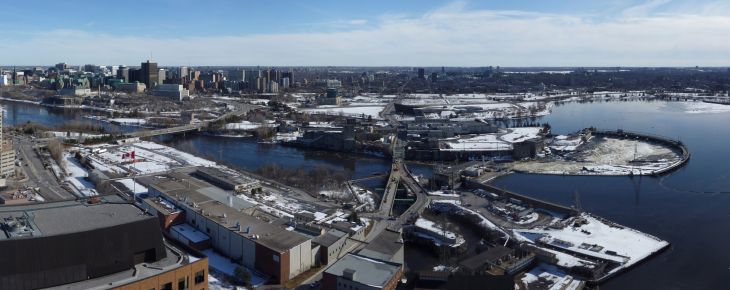

The Victoria-Chaudière Islands area embodies a veritable history book of Canada. Next to the Parliament Buildings, no other place in the Capital is as charged with symbolic meaning for Canadians, yet so little known by residents and visitors alike.
Its story begins with the Great River, la Grande Rivière du Nord. One of the major rivers of North America, the Ottawa is some 700 miles long. The breathtaking natural beauty of the river at the Chaudière, with its setting of islands and the surrounding bluffs (including what is now Parliament Hill) along with the great Chaudière Falls (historically regarded as being second only to the Niagara in grandeur aspect), has played a dominant role in the history of Capital from time immemorial. For so long as the Falls spectacularly punctuated the wilderness, all those who experienced them were moved. The French explorer, Samuel de Champlain, one of the very first Europeans to traverse the Chaudière and witness this site, wrote:
“…we passed a rapid which is half a league wide and has a descent of six or seven fathoms…At one place the water falls with such force upon a rock that with the lapse of time has hollowed out a wide, deep basin. Herein the water whirls around to such an extent, and in the middle sends up such swirls, that the Indians call it “Asticou”, which means “boiler”. This waterfall makes such a noise in this basin that it can be heard for more than two leagues away.”
Besides being a physically spectacular site bridging the mighty Ottawa River, and unifying Aboriginal, English and French cultures in the shadow of the Peace Tower, the Victoria-Chaudière Islands area (a group of several islands, water channels and falls known collectively as “the Chaudière”) is the cradle of the region’s birth and a significant chapter in Canada’s historic development, from prehistory through First Nations eras, to voyageur times, through the nation’s early industrial development of all important water and forest resources. By mid-19th century the Chaudière had rapidly turned into a major industrial engine in Canada. Massive markets opened up for sawn lumber as development of the country expanded westward. The mills and power plants became the most heavily developed hydraulic site and most important sawmill centre in the nation.
Today, the Chaudière Heritage District is a brownfield on Confederation Boulevard. It is ripe for reclamation, reinterpretation and revitalization.
 Wordpress
Wordpress





